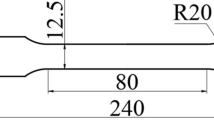Abstract
This paper describes the results of an experimental study on deformation and fracture of a Zr–1% Nb zirconium alloy in the case of multiple loads at low temperatures (−80°C). Samples cut out of pipes and applied as shells of nuclear fuel elements of fuel assemblies of nuclear reactors are used to conduct a series of experiments on low-cycle stretching and compression at low temperatures and study the effect of low temperature on stress relaxation in the material under different numbers of preliminary loads.
Similar content being viewed by others
References
S. Yu. Zavodchikov, L. B. Zuev, and V. A. Kortekhov, Metallurgical Science Issues Devoted to Manufacture of Products of Zirconium Alloy (Nauka, Novisibirsk, 2012) [in Russian].
E. Yu. Rivkin, B. S. Rodchenkov, and V. M. Filatov, The Strength of Zirconium Alloys (Atomizdat, Moscow, 1974) [in Russian].
V. I. Pinakov, A. A. Meshcheryakov, and A. I. Makarov, “Method for Waste-Free Cutting of Thin-Walled Tubes,” RF Patent 2361702 C2, MPK B 23 D 21/00 (2006.01), No. 2007123388/02; Appl. June 21, 2007; Publ. July 20, 2009, Bull. No.20.
B. D. Annin and V. M. Zhigalkin, Behavior of Materials Under Complex Loading (Izd. Sib. Otd. Ross. Akad. Nauk, Novosibirsk, 1999) [in Russian].
S. N. Korobeinikov, Nonlinear Deformation of Solids (Izd. Sib. Otd. Ross. Akad. Nauk, Novosibirsk, 2000) [in Russian].
T. P. Chernyaeva, A. I. Stukalov, and V. M. Gritsina, “Behavior of Oxygen in Zirconium,” in Problems of Nuclear Science and Technology, Ser: Material Science and New Materials, No. 2 (1999).
T. M. Poletika, S. V. Kolosov, and G. N. Narimanova, “Plastic Flow Instability at the Necking Stage in Zirconium Alloys,” Prikl. Mekh. Tekh. Fiz. 47 (3), 141–149 (2006) [J. Appl. Mech. Tech. Phys. 47 (3), 426–432 (2006)].
T. M. Poletika, A. P. Pshenichnikov, and S. L. Girsova, “Plastic Flow Instability and Neck Formation in Zirnonium Alloy,” Fiz. Mezomekh. 9, 99–102 (2006).
T. M. Poletika and A. P. Pshenichnikov, “Nonlinear Neck Formation in Zirconium Alloys,” Prikl. Mekh. Tekh. Fiz. 50 (3), 197–204 (2009) [J. Appl. Mech. Tech. Phys. 50 (3), 525–531 (2009)].
T. M. Poletika, G. N. Narimanov, S. V. Kolosov, et al., Plastic Flow Localization in Commercial Zirconium Alloys (Prikl. Mekh. Tekh. Fiz. 44 (2), 132–142 (2003) [J. Appl. Mech. Tech. Phys. 44 (2), 262–270 (2003)].
V. E. Panin, T. F. Elsukova, and Yu. F. Popkova, “The Role of Curvature of a Crystal Structure in Micropore Formation and Crack Development in Fatigue Fracture of Commercial Titanium,” Dokl. Akad. Nauk 453 (2), 155–158 (2013).
Author information
Authors and Affiliations
Corresponding author
Additional information
Original Russian Text © E.V. Karpov, A.Yu. Larichkin.
Rights and permissions
About this article
Cite this article
Karpov, E.V., Larichkin, A.Y. Deformation and Fracture of Zirconium Alloy at Low Temperatures. J Appl Mech Tech Phy 58, 1130–1137 (2017). https://doi.org/10.1134/S0021894417060207
Received:
Revised:
Published:
Issue Date:
DOI: https://doi.org/10.1134/S0021894417060207




